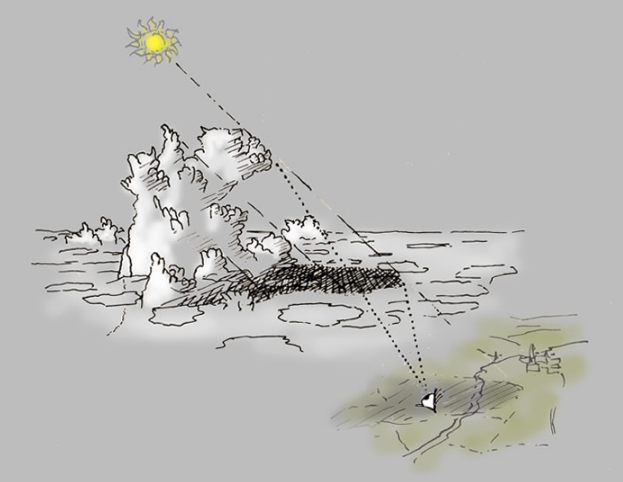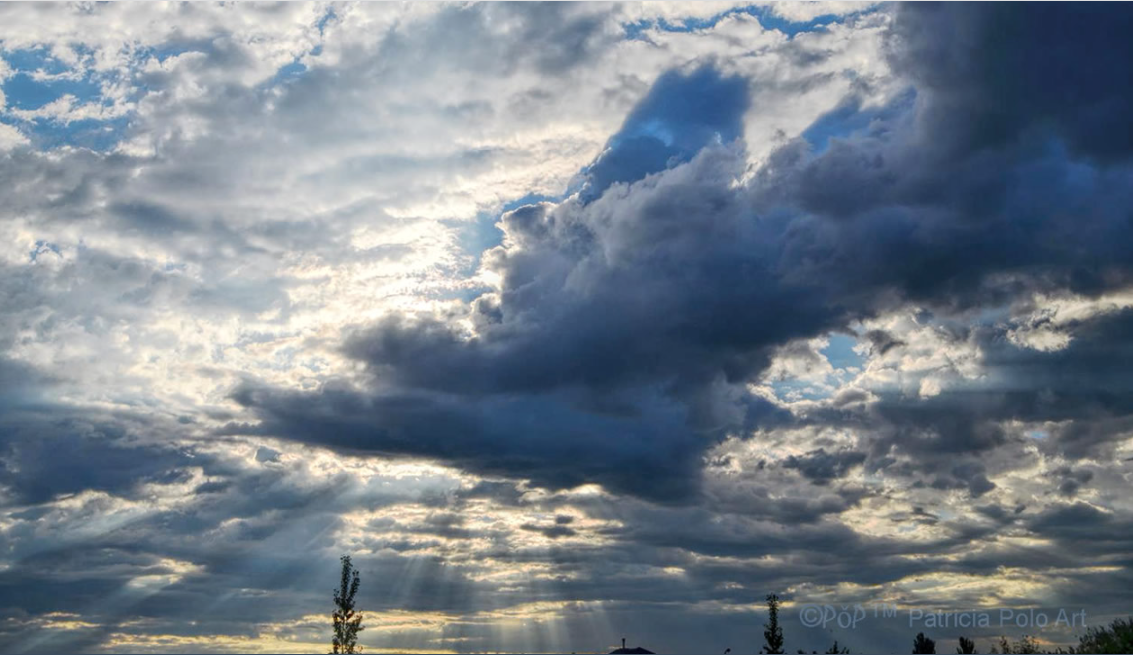Cloud shadows - OPOD
Cloud Shadows - A Trick of Perspective
Cloud shadows can create captivating and dramatic scenes in the sky. As the sun shines downwards, shadows typically point down as well. However, there are instances where appearances can be deceiving. Some shadows may appear to project upwards onto a higher layer of clouds, giving rise to a fascinating trick of perspective.
In the image captured by Patricia Polo at Lethbridge, Alberta, Canada, we can observe a particularly striking cloud shadow. The shadow seems to defy gravity as it appears to project above the towering cumulus clouds. However, this illusion is a result of the interplay between different cloud layers and atmospheric conditions.
The scene in the photograph reveals the presence of thin clouds and stratus haze below the towering cumulus clouds. The shadow cast by the cumulus clouds falls onto this lower layer, creating the illusion of an upward projection when viewed from certain positions on the ground.
The phenomenon of cloud shadows projecting upwards can also be attributed to atmospheric refraction. When the sun is positioned just below or almost below the horizon, its rays can undergo a bending effect due to atmospheric refraction. This refraction causes the rays to curve slightly upwards, at an angle no greater than a fraction of a degree.
While the concept of cloud shadows may appear simple at first glance, there are several factors at play that contribute to their formation and unique appearance. Let's explore some key aspects:
Factors Influencing Cloud Shadows:
-
Cloud Types: Different cloud types can influence the formation and appearance of cloud shadows. Cumulus clouds, with their towering structure, are particularly notable for casting shadows onto lower cloud layers.
-
Cloud Layering: The presence of multiple cloud layers can create intriguing shadow effects. When a higher layer of clouds casts its shadow onto a lower layer, it can give the illusion of upward projection.
-
Atmospheric Conditions: The atmospheric conditions, including the presence of haze or mist, can affect the visibility and intensity of cloud shadows. Thin clouds and stratus haze, as seen in the photograph, can contribute to the unique appearance of the shadow.
-
Sun's Position: The position of the sun relative to the observer and the clouds plays a crucial role in the formation and perception of cloud shadows. The angle of the sun's rays can determine the direction and length of the shadow.
The Science Behind Cloud Shadows:
Cloud shadows are a result of the interaction between light, clouds, and the observer's perspective. When sunlight encounters clouds, it undergoes scattering and absorption. The areas where the sunlight is blocked by clouds create shadows.
The shape and form of cloud shadows are influenced by the shape and height of the clouds themselves. Cumulus clouds, with their towering vertical structure, cast elongated shadows that can stretch across the sky. The angle at which the sunlight interacts with these clouds determines the length and direction of the shadow.
The illusion of upward projection occurs when a cumulus cloud shadow falls onto a lower cloud layer. From certain vantage points on the ground, the shadow tip may appear to extend above the cumulus tops, creating a visually captivating effect.
Atmospheric refraction further enhances this illusion. When the sun is near or below the horizon, its rays can bend slightly upwards due to refraction. This bending effect contributes to the perceived upward projection of the cloud shadow, adding an element of mystique to the phenomenon.
Appreciating Cloud Shadows:
Cloud shadows offer a unique opportunity to observe and appreciate the dynamic nature of our atmosphere. Their ever-changing shapes and interplay with different cloud layers create mesmerizing scenes that captivate both photographers and sky enthusiasts alike.
To fully appreciate cloud shadows, consider these tips:
-
Observe from Different Perspectives: Move around and explore different viewpoints to witness the varying appearances of cloud shadows. Changing your vantage point can reveal new dimensions and perspectives.
-
Timing is Key: Cloud shadows are most pronounced when the sun is low on the horizon, either during sunrise or sunset. The oblique angle of the sunlight accentuates the length and direction of the shadows, enhancing their visual impact.
-
Document the Beauty: Capture the beauty of cloud shadows through photography or other artistic mediums. Experiment with different camera angles, exposure settings, and compositions to convey the unique atmosphere and mood.
In conclusion, cloud shadows provide a fascinating glimpse into the intricate interplay between light, clouds, and our perspective as observers. Their upward projection is a trick of perspective influenced by cloud types, layering, atmospheric conditions, and the position of the sun. By appreciating and documenting these ethereal phenomena, we can gain a deeper understanding of the ever-changing dynamics of our atmosphere.

Cloud Shadows
Patricia Polo (Patricia Polo Art) captured this dramatic and apparently upward going cloud shadow in a morning sky at Lethbridge, Alberta, Canada.
Images ©Patricia Polo, shown with permission.

The sun always, or nearly always. shines downwards and therefore shadows nearly always point down.
Yet appearances can deceive. These shadows, like many, look as though they are projecting upwards onto a higher cloud layer - A trick of perspective. There is thin cloud and stratus haze below the towering cumulus. The cumulus shadow is cast down onto this lower layer. Viewed from some positions on the ground the shadow tip appears to project above the cumulus tops.
. When the sun is almost below the horizon or even just below it, atmospheric refraction can curve its rays around the earth and make them slant very slightly (no more than a fraction of a degree) upwards.

Note: this article has been automatically converted from the old site and may not appear as intended. You can find the original article here.
Reference Atmospheric Optics
If you use any of the definitions, information, or data presented on Atmospheric Optics, please copy the link or reference below to properly credit us as the reference source. Thank you!
-
<a href="https://atoptics.co.uk/blog/cloud-shadows-opod/">Cloud shadows - OPOD</a>
-
"Cloud shadows - OPOD". Atmospheric Optics. Accessed on November 22, 2024. https://atoptics.co.uk/blog/cloud-shadows-opod/.
-
"Cloud shadows - OPOD". Atmospheric Optics, https://atoptics.co.uk/blog/cloud-shadows-opod/. Accessed 22 November, 2024
-
Cloud shadows - OPOD. Atmospheric Optics. Retrieved from https://atoptics.co.uk/blog/cloud-shadows-opod/.